Description
The inscription consists of runic text on two intertwined serpents that form an oval around a Christian cross. [1] The runestone is an example of the Ringerike style, [1] and it is categorized as being carved in runestone style Pr1. The runestone was raised by two women named Gyrið and Guðlaug in memory of the master of the homestead whose name was Andsvarr and in memory of their father whose name was engraved as unif. These runes are interpreted as Ónæm, the accusative case of Ónæmr, a name which means "Slow Learner." A man having this rare name, Ónæmr, is also mentioned on two nearby runestones, U 112 in Kyrkstigen and U 336 in Orkesta, and so the three runestones are held to refer to the same person. [2]
The other runestones tell of the family of the two women, their father and the runemaster who made it. The runemaster Ulf of Borresta declared on U 336 that he was Ónæmr's paternal nephew, and consequently he was Gyrið and Guðlaug's first cousin. Ulf is notable in himself since the runestone U 344 in Yttergärde declares that Ulf had taken three danegelds in England. The first one was with Skagul Toste in 991, the second one with Thorkel the High in 1012 and the last one with Canute the Great in 1018. [2] [3] [4] [5]
The runestone U 112 in Kyrkstigen informs that a maternal nephew of Ónæmr was Ragnvaldr who was the commander of the Varangian Guard in Constantinople. Ragnvaldr had the runestone U 112 made in memory of himself and his mother, Ónæmr's daughter. [2]
Ónæmr's daughter Guðlaug appears to have had the son Holmi who fell in Italy which is mentioned on the runestone U 133 in Täby. [3] It is likely that Holmi fell in battle as a member of the Varangian Guard in southern Italy.
Andsvarr (an allomorph of Özurr and Assur), in memory of whom the runestone also was raised, may be the same man as the housecarl who is mentioned on the runestone U 330 in Snottsta. [6] Gyríðr is also mentioned on U 100 in Skälby and U 226 in Bällsta. [7]
The runic text ends with the imperitive Rað þessi! which is translated as "Interpret these!" Other runestones with similar imperitive exclamations in their runic texts include U 29 in Hillersjö and Sö 158 in Österberga. [8] The runes for this phrase, raþisi, are carved on the serpent's tail and follow the rule that double consonants are represented with only a single consonant, even if one of the two consonants are at the end of one word and the second is at the beginning of the next word. [9] The transliteration of the runic text for this phrase, raþ| |þisi, shows a separate þ-rune for each of the two words.
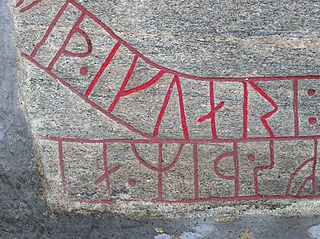
Ingvar the Far-Travelled led a large Viking attack against Iran in 1036–1042.
The Runestones of Högby are runestones located in the village of Högby in Östergötland, Sweden, but the name Högby runestone usually refers to the notable Ög 81. It is famous for its eloquent epitaph in fornyrðislag for all the five sons of a man. The runestone was found when the church was demolished in 1874. Fragments of some other runestones were found as well. The Rundata project dates them to the late 10th century.

The Snottsta and Vreta stones are individual runestones known as U 329, U 330, U 331 and U 332. They are found on the homesteads of Snottsta and Vreta, and they tell in Old Norse with the younger futhark about the family story of Gerlög and Inga in 11th century Uppland, Sweden, together with the Hillersjö stone and the runestone U 20/21.

The Jarlabanke Runestones is the name of about 20 runestones written in Old Norse with the Younger Futhark rune script in the 11th century, in Uppland, Sweden.

The Hakon Jarl Runestones are Swedish runestones from the time of Canute the Great.

The Ingvar Runestones is the name of around 26 Varangian Runestones that were raised in commemoration of those who died in the Swedish Viking expedition to the Caspian Sea of Ingvar the Far-Travelled.

The Orkesta Runestones are 11th century runestones engraved in Old Norse with the younger futhark that are located at the church of Orkesta north-east of Stockholm in Sweden.

The Hagby Runestones are four runestones that are raised on the courtyard of the farm Hagby in Uppland, Sweden. They are inscribed in Old Norse using the Younger Futhark and they date to the 11th century. Three of the runestones are raised in memory of Varangians who died somewhere in the East, probably in Kievan Rus'.

The Greece runestones are about 30 runestones containing information related to voyages made by Norsemen to the Byzantine Empire. They were made during the Viking Age until about 1100 and were engraved in the Old Norse language with Scandinavian runes. All the stones have been found in modern-day Sweden, the majority in Uppland and Södermanland. Most were inscribed in memory of members of the Varangian Guard who never returned home, but a few inscriptions mention men who returned with wealth, and a boulder in Ed was engraved on the orders of a former officer of the Guard.

The Italy runestones are three or four Varangian runestones from 11th-century Sweden that tell of warriors who died in Langbarðaland, the Old Norse name for Italy. On these rune stones it is southern Italy that is referred to (Langobardia), but the Rundata project renders it rather anachronistically as Lombardy.
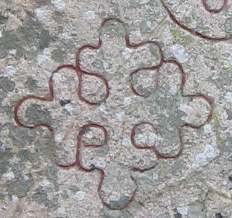
The Risbyle Runestones are two runestones found near the western shore of Lake Vallentunasjön in Uppland, Sweden, dating from the Viking Age.
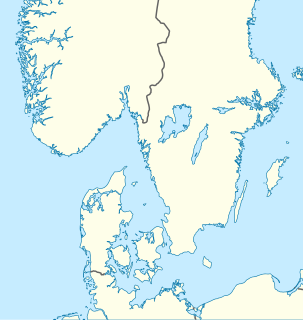
The England runestones is a group of about 30 runestones in Sweden which refer to Viking Age voyages to England. They constitute one of the largest groups of runestones that mention voyages to other countries, and they are comparable in number only to the approximately 30 Greece Runestones and the 26 Ingvar Runestones, of which the latter refer to a Viking expedition to the Middle East. They were engraved in Old Norse with the Younger Futhark.

The Gardarike Runestones are runestones in Scandinavia that mention voyages to the East (Austr) or the Eastern route (Austrvegr), or to more specific eastern locations such as Garðaríki.

The Viking runestones are runestones that mention Scandinavians who participated in Viking expeditions. This article treats the runestone that refer to people who took part in voyages abroad, in western Europe, and stones that mention men who were Viking warriors and/or died while travelling in the West. However, it is likely that all of them do not mention men who took part in pillaging. The inscriptions were all engraved in Old Norse with the Younger Futhark. The runestones are unevenly distributed in Scandinavia: Denmark has 250 runestones, Norway has 50 while Iceland has none. Sweden have as many as between 1,700 and 2,500 depending on definition. The Swedish district of Uppland has the highest concentration with as many as 1,196 inscriptions in stone, whereas Södermanland is second with 391.

The Baltic area runestones are Varangian runestones in memory of men who took part in peaceful or warlike expeditions across the Baltic Sea, where Finland and the Baltic states are presently located.
Ragnvaldr was a captain of the Varangian Guard in the first half of the 11th century. He may appear on several runestones, some of which suggest that he was the son of an Ingvar connecting him to the Jarlabanke clan.
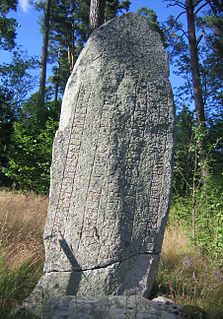
Freygeirr was a Viking chieftain who probably led a leidang expedition. He is considered to have been active in the 1050s on the Baltic coast, and he has been identified on six runestones, Gs 13, DR 216, U 518, U 611, U 698 and U 1158. One of the three brothers who is mentioned on the Stenkvista runestone, which is adorned with a heathen symbol (Mjölnir), is also called Freygeirr.

Ulf of Borresta was a runemaster in the eleventh century Uppland, Sweden, and a successful Viking who returned from England three times with a share of the Danegeld. He is named after his estate which in modern Swedish is called Borresta or Bårresta.
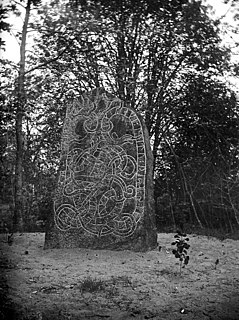
Uppland Runic Inscription 1158 or U 1158 is the Rundata catalog listing for a Viking Age memorial runestone that is located at Stora Salfors, which is one kilometer east of Fjärdhundra, Uppsala County, Sweden, and is in the historic province of Uppland. The stone is a memorial to a man named Freygeirr, and may have been the same Freygeirr who was a Viking chieftain active on the Baltic coast in the 1050s.
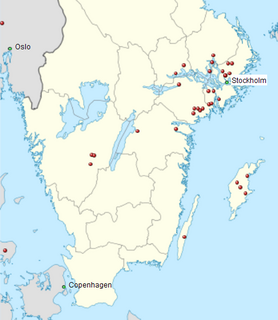
The Varangian runestones are runestones in Scandinavia that talk of eastward voyages such as the Gardarike runestones, Greece Runestones, Italy Runestones, and inscriptions left by the Varangian Guard. Other runestones that deal with Varangian expeditions include the Serkland Runestones and the Ingvar Runestones. There is also a separate article for the Baltic expeditions runestones.













